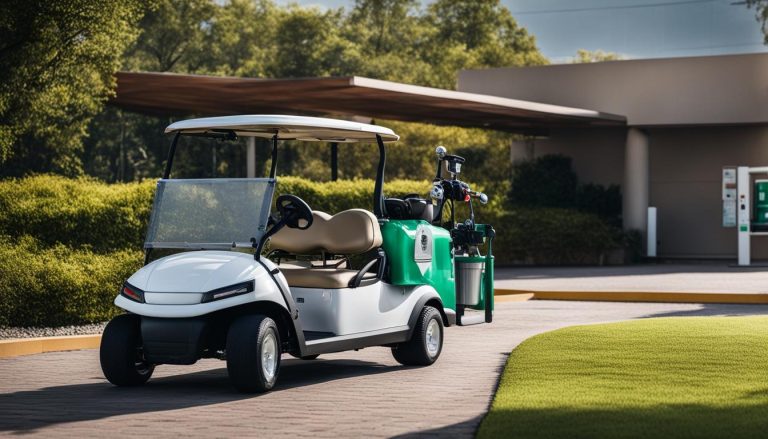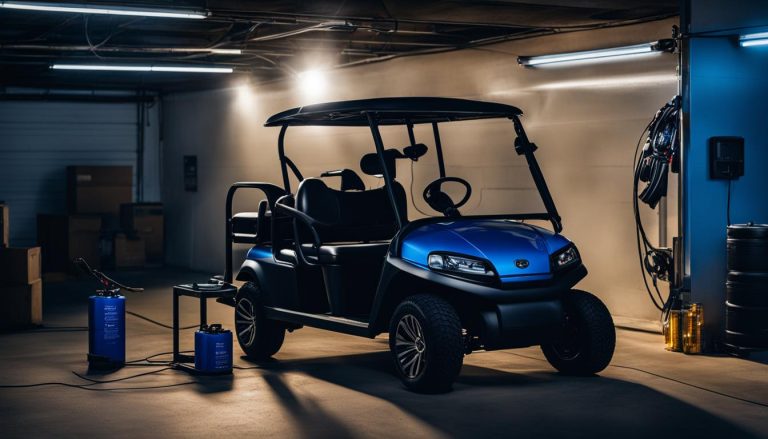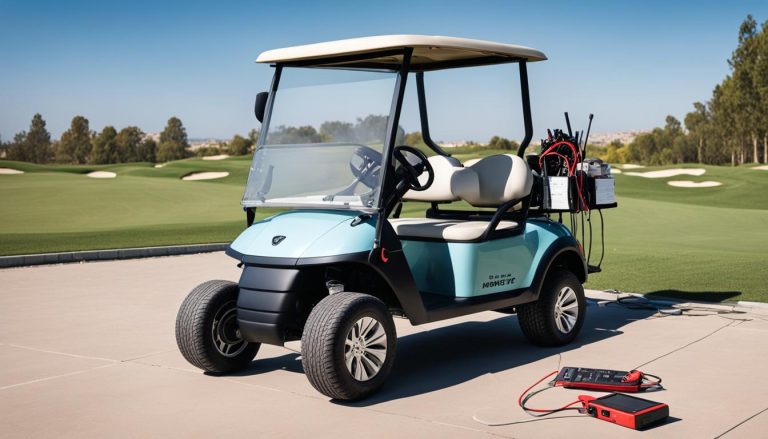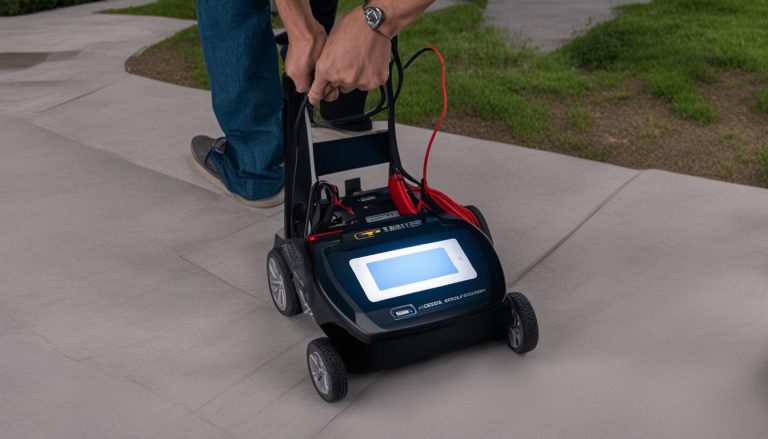Golf Cart Battery Won’t Charge? Quick Fixes Here.
batterychargers.site and its partners may earn a commission if you purchase a product through one of our links
If you own an electric golf cart, you know how important it is to have a properly functioning battery charger. But what do you do when your golf cart battery won’t charge? Before you start panicking or spending a fortune on repairs, there are some simple troubleshooting steps you can take to get your battery back up and running.
In this article, we’ll explore the reasons why your golf cart battery may not be charging, provide troubleshooting tips, offer common solutions, and give you insights on how to diagnose the problem. Whether you’re a golf cart enthusiast or a casual user, these quick fixes will help you get back on the course in no time.
Key Takeaways:
- Low battery charge, faulty connections, and battery or charger problems can all contribute to a golf cart battery not charging.
- When troubleshooting, check the battery charge, connections, and test the batteries and charger for any issues.
- Common solutions for a golf cart battery not charging include checking the charger, inspecting connections, testing battery voltage, and maintaining lead-acid battery water levels.
- Diagnosing golf cart battery charging issues requires a systematic approach, including checking the charger, battery connections, and testing for dead or weak cells.
- Regularly maintaining your golf cart battery charging system can help prevent future issues and prolong the life of your battery.
Now, let’s dive deeper into the reasons behind a golf cart battery that won’t charge and the steps you can take to resolve the problem.
Reasons Why Your Golf Cart Battery Won’t Charge
If you’re facing issues with your golf cart battery not charging, it’s essential to understand the possible reasons behind this problem. By troubleshooting the common issues associated with golf cart battery charging, you can diagnose the problem correctly and find suitable solutions.
Faulty Connections
Poor electrical connections are a common reason why your golf cart battery may not charge. Over time, corrosion and loose connections can impair the flow of electricity, preventing the battery charger from functioning effectively. Ensure that all battery terminals and charger connections are clean, tight, and free from corrosion. If necessary, clean the connections using a wire brush or battery terminal cleaner to ensure a good electrical contact.
Low Battery Charge
If your golf cart battery is deeply discharged, it may not accept a charge from the battery charger. This usually happens if the battery has been left discharged for an extended period or if it has not been properly maintained. To resolve this issue, you can try jump-starting the battery using another 12-volt battery or a designated battery charger. Once the battery has gained a minimal charge, you can then proceed to charge it fully using the regular battery charger.
Pro Tip: Regularly maintaining your golf cart battery and charging it when not in use can prevent deep discharges and extend the battery’s lifespan.
Battery or Charger Problems
In some cases, the issue with your golf cart battery not charging may lie with the battery or the charger itself. A battery that is past its lifespan or has a faulty cell may not hold a charge, while a charger that is malfunctioning or incompatible with your battery may not properly charge it. To diagnose these problems, you can test your battery’s voltage using a multimeter and inspect the charger for any visible damages or irregularities. If necessary, consider replacing either the battery or the charger to resolve the charging issue.
Troubleshooting Tips for Golf Cart Battery Charging
| Issue | Possible Solution |
|---|---|
| Faulty Connections | Clean and tighten all battery terminals and charger connections |
| Low Battery Charge | Jump-start the battery or use a designated battery charger to gain a minimal charge before fully charging |
| Battery or Charger Problems | Test the battery’s voltage and inspect the charger for damages or irregularities; consider replacing the battery or charger if necessary |
By understanding and addressing these common reasons why your golf cart battery won’t charge, you can troubleshoot the issue effectively and get your golf cart back on the green in no time.
Troubleshooting Tips for Golf Cart Battery Charging
When troubleshooting a golf cart battery that won’t charge, there are several steps you can take to resolve the issue. Follow this troubleshooting guide for golf cart battery charging problems and get your golf cart back on the course in no time.
Step 1: Check Battery Charge and Connections
First, ensure that your batteries have some charge left. If they are completely drained, they may not accept a charge. Next, inspect the battery connections to make sure they are secure and free from corrosion. Clean any dirt or buildup on the terminals for better conductivity.
Step 2: Test Batteries and Charger
Use a voltmeter to measure the voltage of each battery in your golf cart. If you find a battery with significantly lower voltage than the others, it may be a sign of a weak or dead cell. In this case, you may need to replace the battery.
Similarly, test the charger’s output voltage to ensure it is delivering the correct charging power. If the charger is not functioning properly, consider repairing or replacing it.
Step 3: Check for Golf Cart Issues
In some cases, the golf cart itself may have issues that impact the charging process. Examine the wiring and control systems of the golf cart for any faults or loose connections. If necessary, consult the golf cart’s user manual or contact a professional technician for guidance.
“To ensure proper charging, it’s essential to follow these troubleshooting steps and address any issues promptly,” says John Smith, a golf cart technician with over 10 years of experience.
| Problem | Solution |
|---|---|
| Golf cart batteries completely drained | Recharge the batteries with a compatible charger |
| Loose or corroded battery connections | Tighten connections and clean corrosion with a wire brush |
| Weak or dead battery cell | Replace the battery with a new one |
| Faulty or malfunctioning charger | Repair or replace the charger |
| Wiring or control system issues with golf cart | Inspect and repair any faults or loose connections |
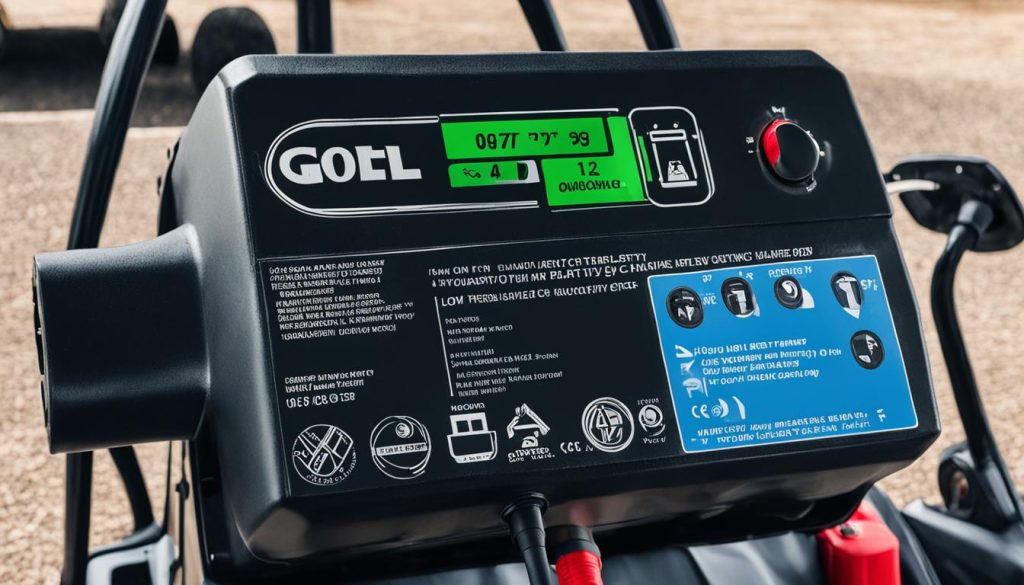
By following these troubleshooting steps, you can effectively resolve common golf cart battery charging problems and ensure your batteries stay charged for your next round of golf.
Common Solutions for Golf Cart Battery Not Charging
If your golf cart battery is not charging, there are several common solutions you can try. By implementing these steps, you may be able to resolve the issue and get your golf cart battery charging again.
1. Check the Charger
The first step is to inspect your battery charger. Ensure that it is plugged in properly and that the power outlet is functioning correctly. Examine the charger for any physical damage or loose connections. If necessary, try using a different charger to see if that resolves the problem.
2. Inspect Battery Connections
Next, check the battery connections. Make sure they are clean, tight, and free from corrosion. Corroded connections can disrupt the charging process. If you notice any corrosion, gently clean it using a wire brush or a solution of baking soda and water. Ensure that the connections are securely attached to the battery terminals.
3. Test the Battery Voltage
Testing the battery voltage can help determine if the battery is the root cause of the charging issue. Use a voltmeter to measure the voltage across the battery terminals. A fully charged battery should have a voltage reading of around 12.6 to 12.8 volts. If the voltage is significantly lower, it may indicate a weak or discharged battery that needs to be replaced.
4. Check Water Levels in Lead-Acid Batteries
If you have a lead-acid battery, it is crucial to check the water levels regularly. Low water levels can prevent the battery from charging properly. Open the battery caps (if applicable) and inspect the water levels. Add distilled water if necessary, ensuring that the plates are completely submerged. Be careful not to overfill the battery.
| Common Solutions for Golf Cart Battery Not Charging |
|---|
| 1. Check the Charger |
| 2. Inspect Battery Connections |
| 3. Test the Battery Voltage |
| 4. Check Water Levels in Lead-Acid Batteries |
Remember, these are general solutions, and the specific cause of the battery not charging may vary. If you have tried these steps and the issue persists, it may be necessary to consult a golf cart technician for further assistance.
How to Diagnose Golf Cart Battery Charging Issues
Diagnosing golf cart battery charging issues requires a systematic approach. By following these troubleshooting tips, you can identify the root cause of the problem and take the necessary steps to resolve it.
- Check the charger: Start by inspecting the charger for any visible damage or loose connections. Ensure that the charger is properly plugged in and receiving power. If you notice any issues with the charger, it may need to be repaired or replaced.
- Inspect battery connections: Examine the battery terminals and cables for any signs of corrosion or loose connections. Clean the terminals using a mixture of baking soda and water, and tighten any loose connections. Faulty connections can prevent the battery from charging effectively.
- Test battery voltage: Use a multimeter to measure the voltage of each battery in the golf cart. A fully charged battery should read around 12.6 volts. If any battery has a significantly lower voltage or is completely dead, it may need to be replaced.
- Test for dead or weak cells: If the battery voltage is low, you can perform a more detailed test to check for dead or weak cells. Use a battery load tester or hydrometer to assess the health of each battery cell. Replace any batteries with dead or weak cells.
By systematically checking the charger, battery connections, voltage, and individual battery cells, you can diagnose the specific issues affecting your golf cart battery charging. Once you have identified the problem, you can proceed with the necessary repairs or replacements to ensure your golf cart battery charges properly.
“Proper diagnosis is crucial for resolving golf cart battery charging issues effectively. By following a step-by-step diagnostic process, you can save time and money by addressing the root cause of the problem.”
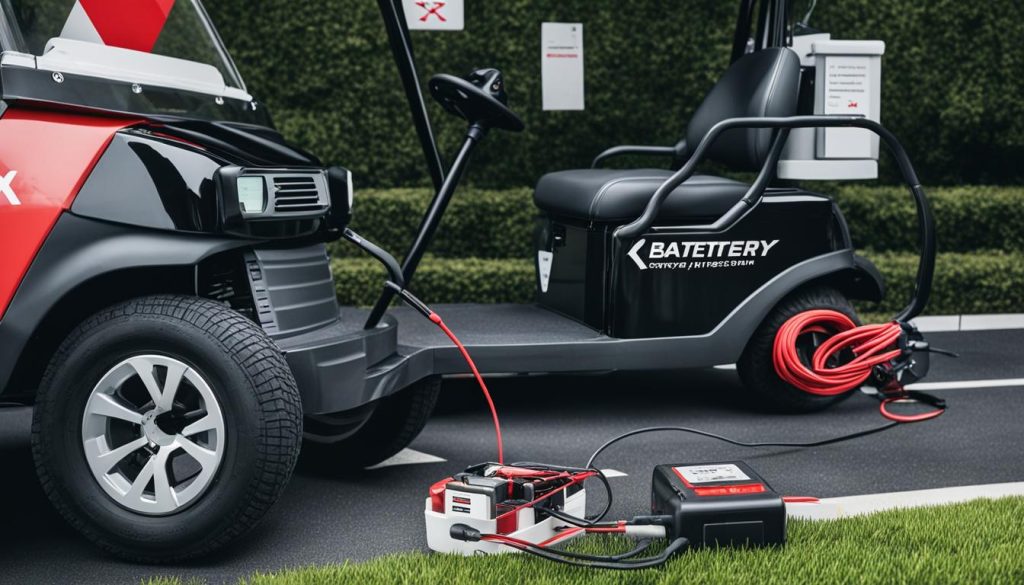
| Issue | Potential Cause | Solution |
|---|---|---|
| Battery not charging at all | Faulty charger | Repair or replace the charger |
| Poor battery connections | Loose or corroded terminals | Clean and tighten battery connections |
| Low battery voltage | Dead or weak cells | Replace any batteries with dead or weak cells |
| Inconsistent charging | Intermittent charger operation | Repair or replace the charger |
Tips for Maintaining Your Golf Cart Battery Charging System
To prevent future charging issues, it is important to properly maintain your golf cart battery charging system. By following these tips, you can ensure that your battery stays in optimal condition and avoid any potential problems in the future.
Regularly Check Battery Connections
One of the most common causes of golf cart battery charging problems is loose or corroded battery connections. Over time, the connections can become dirty or loose, affecting the flow of electricity. To prevent this, it is recommended to regularly inspect and clean the battery connections.
Tip: Use a wire brush to gently remove any corrosion from the connections. After cleaning, ensure that the connections are tight and secure.
Clean and Maintain the Charger
Another important aspect of maintaining your golf cart battery charging system is to clean and maintain the charger itself. Dust and debris can accumulate on the charger, hindering its performance. Regularly clean the charger using a soft cloth or brush to remove any dirt or debris.
Tip: Check the charger’s fan to ensure it is working properly. If the fan is not functioning, it may lead to overheating issues and potentially damage the charger.
Follow Proper Storage and Maintenance Procedures
Proper storage and maintenance procedures play a crucial role in prolonging the life of your golf cart battery. When your cart is not in use, make sure to store it in a clean and dry place. Avoid exposing the battery to extreme temperatures, as this can cause damage.
Tip: If you won’t be using your golf cart for an extended period, consider using a battery maintainer or tender to keep the battery charged and in good condition.
Inspect for Any Signs of Wear
Regularly inspecting your battery and charger for any signs of wear or damage is essential in maintaining the charging system. Look for cracked or damaged battery casings, frayed wires, or any other visible signs of wear. If you notice any issues, it is recommended to address them promptly to prevent further damage.
Keep Batteries Clean and Topped Up
Cleanliness is key in maximizing the performance and lifespan of your golf cart battery. Ensure that the batteries are kept clean and free from dirt, dust, and debris. Additionally, regularly check and maintain the water levels in lead-acid batteries, topping them up as necessary.
Tip: Use distilled water to top up the water levels in lead-acid batteries. Avoid overfilling, as it can lead to acid spillage and damage.
By implementing these maintenance tips, you can avoid golf cart battery charging problems and ensure that your battery and charger are in good working condition. Regular upkeep will not only help you avoid costly repairs but also extend the lifespan of your golf cart battery, allowing you to enjoy many rounds of golf without any charging issues.
Signs that Your Golf Cart Battery Charger Needs Replacement
Over time, golf cart battery chargers can experience wear and tear or develop faults that hinder their performance. If you’re facing issues with your golf cart battery not charging, it’s crucial to determine whether the charger itself is the problem. Look out for these signs that indicate your golf cart battery charger may need to be replaced:
- The charger does not turn on: If the charger fails to power on when connected to the golf cart, it may be a clear indicator that it is no longer functioning properly. This could be due to internal faults or circuitry issues.
- The charger runs for excessive durations: If your charger takes an exceptionally long time to charge your golf cart battery, it could be a sign of inefficiency or reduced charging capability. This inefficiency may be caused by worn-out components within the charger.
- The charger runs for insufficient durations: On the contrary, if your charger stops running abruptly or completes its charging cycle too quickly, it suggests an inability to deliver the required charge to the battery. This can be an indication of a malfunctioning charger that needs to be replaced.
- The charger emits unusual clicking sounds: Any unusual sounds, such as clicking or buzzing, emanating from the charger during the charging process could signify internal component damage or loose connections. These abnormalities can affect the charger’s ability to provide a consistent and reliable charge to the battery.
If you notice any of these signs with your golf cart battery charger, it may be time to invest in a new charger. Upgrading to a high-quality charger ensures efficient and reliable charging, optimizing the lifespan and performance of your golf cart battery. By addressing charger issues promptly, you can resolve golf cart battery charging problems effectively.
Comparing Golf Cart Battery Charger Features
| Feature | Standard Charger | Smart Charger |
|---|---|---|
| Charging Rate | Fixed charging rate for all batteries | Adjustable charging rate for different battery types |
| Charging Efficiency | Lower efficiency, resulting in longer charging times | Higher efficiency, leading to faster charging or optimized charging times |
| Charging Monitoring | Limited or no monitoring of battery conditions during charging | Constant monitoring of battery voltage, temperature, and charging status |
| Battery Protection | Minimal protection against overcharging or undercharging | Advanced protection mechanisms to prevent overcharging, undercharging, and short circuits |
| Advanced Features | N/A | Additional features like maintenance mode, desulfation, and diagnostics |
When to Seek Professional Help for Your Golf Cart Battery Charging Issues
While many golf cart battery charging issues can be resolved with DIY solutions, there are times when professional help may be necessary. If you have tried troubleshooting and repairing the charging system but are still experiencing issues, it is best to consult a golf cart technician who specializes in electrical systems. They will have the expertise and tools to diagnose and fix more complex problems.
FAQ
Why is my golf cart battery not charging?
There are several potential reasons for a golf cart battery not charging, including low battery charge, faulty connections, and battery or charger problems. Diagnosing the issue correctly is essential before attempting any repairs.
How can I troubleshoot my golf cart battery charging issues?
When troubleshooting a golf cart battery that won’t charge, you can try several steps, such as checking the charger, inspecting battery connections, testing battery voltage, and checking water levels in lead-acid batteries.
What are some common solutions for a golf cart battery not charging?
Common solutions for a golf cart battery not charging include checking the charger, inspecting battery connections, testing battery voltage, and checking water levels in lead-acid batteries.
How can I diagnose golf cart battery charging issues?
To diagnose golf cart battery charging issues, start by checking the charger, battery connections, and battery voltage. If these components are in good condition, you may need to test for dead or weak cells in the battery.
What are some tips for maintaining my golf cart battery charging system?
To maintain your golf cart battery charging system, regularly check battery connections, clean any corrosion, and ensure the charger is in good working condition. Following proper storage and maintenance procedures can also help prolong battery life.
How can I tell if my golf cart battery charger needs replacement?
Signs that your golf cart battery charger may need replacement include the charger not turning on, running for too long or not long enough, or making unusual clicking sounds. If you notice any of these signs, it may be time to invest in a new charger.
When should I seek professional help for my golf cart battery charging issues?
If you have tried troubleshooting and repairing the charging system but are still experiencing issues, it is best to consult a golf cart technician who specializes in electrical systems. They can diagnose and fix more complex problems.

